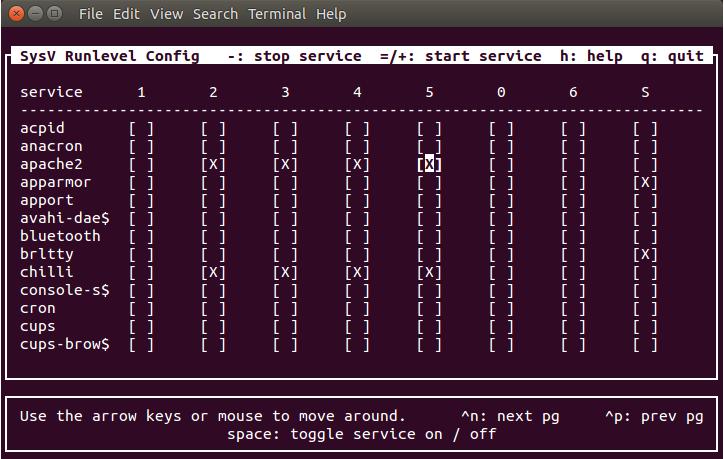1、软件环境:
Ubuntu 14.04.1 LTS (GNU/Linux 3.13.0-32-generic x86_64)
MySQL 5.6.27 x64
2、方法一
最简单的方法是执行命令:
# update-rc.d mysql defaults
Adding system startup for /etc/init.d/mysql ...
/etc/rc0.d/K20mysql -> ../init.d/mysql
/etc/rc1.d/K20mysql -> ../init.d/mysql
/etc/rc6.d/K20mysql -> ../init.d/mysql
/etc/rc2.d/S20mysql -> ../init.d/mysql
/etc/rc3.d/S20mysql -> ../init.d/mysql
/etc/rc4.d/S20mysql -> ../init.d/mysql
/etc/rc5.d/S20mysql -> ../init.d/mysql
注意:移除MySQL的开机服务可执行命令update-rc.d mysql remove
3、方法二
第二种方法是使用sysv-rc-conf工具,执行命令:
# apt-get install sysv-rc-conf
# sysv-rc-conf
打开了命令行方式的自启动服务管理界面:

用鼠标点击,也可以用键盘方向键定位,用空格键选择, “X”表示开启该服务。用Ctrl+N翻下一页,用Ctrl+P翻上一页,用Q退出。
也可以用命令:
# sysv-rc-conf --level 2345 mysql off
注意:Ubuntu系统中服务的运行级别
0 系统停机状态
1 单用户或系统维护状态
2~5 多用户状态
6 重新启动
4、方法三
第三种方法是使用chkconfig工具,执行命令:
# apt-get install chkconfig
# chkconfig mysql --list
mysql 0:off 1:off 2:off 3:off 4:off 5:off 6:off
如果mysqld没有在列表,那么用命令添加它:
# chkconfig add mysql
我们可以看到,mysqld本来就在列表中,所以这一步我们跳过。
使用命令设置开机启动:
# chkconfig --add mysql
# chkconfig mysql --list
mysql 0:off 1:off 2:on 3:on 4:on 5:on 6:off
表示MySQL的开机自启动已经设置完成。
Ubuntu下设置MySQL自启动故障解决一例:http://www.linuxdiyf.com/linux/9383.html
Ubuntu创建开机自启动脚本的方法:http://www.linuxdiyf.com/linux/5316.html
管理Linux启动项-停止MySQL自启动:http://www.linuxdiyf.com/linux/3015.html
Ubuntu取消Apache及MySQL等自启动:http://www.linuxdiyf.com/linux/640.html

